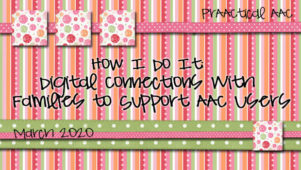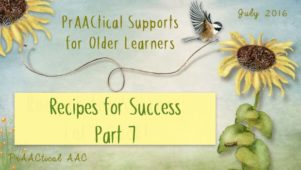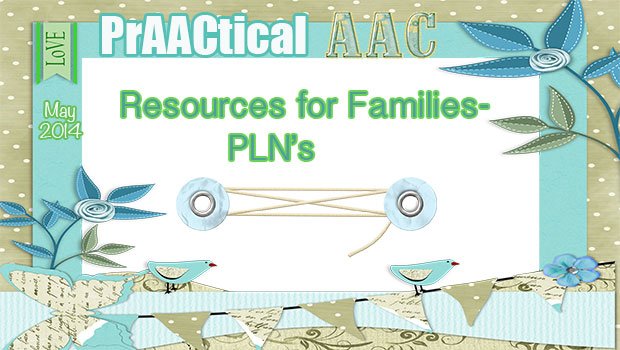Home Programming with AAC
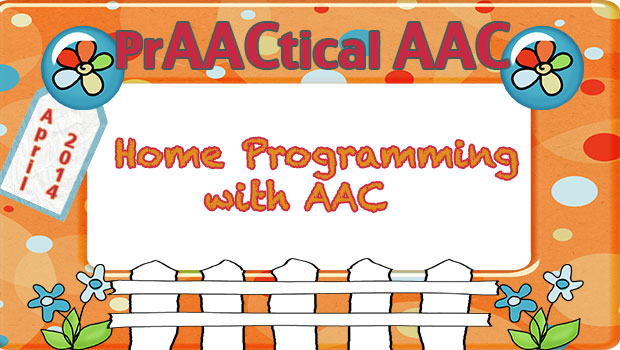
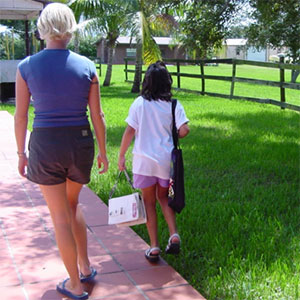 As SLP’s we love to have families learn and carryover the work we do in speech-language treatment sessions. This helps ensure carryover of progress and generalization of therapy success. However, as Carole clearly illustrated last Monday, there are a lot of family dynamics, cultural issues, and family challenges that make adding extra work possibly burdensome. We really (really) do not want to burden families, but its beneficial to have AAC communication happen all day long.
As SLP’s we love to have families learn and carryover the work we do in speech-language treatment sessions. This helps ensure carryover of progress and generalization of therapy success. However, as Carole clearly illustrated last Monday, there are a lot of family dynamics, cultural issues, and family challenges that make adding extra work possibly burdensome. We really (really) do not want to burden families, but its beneficial to have AAC communication happen all day long.
We once had a client who had a very huge house with lots of bedrooms, but mom chose to keep her children together in one bedroom. This was just in case the AAC user woke in the middle of the night. Then she would have someone close by as a communication partner. This was a family who took home programming to the max and expanded and modified it to fit their family.
A main issue in home programming or ‘speech homework’ is making it work for families and caregivers (even educators) so that it can happen. We often say AAC can not be learned through isolated homework or exercises. We love when home programming happens all the time and in authentic family activities. There are no specific ‘home programming’ rules or absolutes, however, here are some ideas and considerations that help make it more likely that families will take the time and effort to be an AAC partner and complete a variety of AAC home activities.
Main Considerations for Home Programming
- Look for activities that occur naturally in the home. Consider baths, meals, tv time, or nighttime routines. Ask families what they do everyday. Some families go to the playground or take a drive, while others play games. Home programming can involve specific written out communication opportunities that get embedded for AAC prAACtice within these activities. The same principles can be applied to educators. We do not need to add tasks, but figure out how to increase AAC implementation within current tasks and activities.
- Provide any needed AAC or activity materials to the family, caregiver, or educator. When there is easy access to the materials needed to complete the home program, it is one less step that has to be thought about. Many families have expressed great appreciation for being given the materials. Some prAACtices even have lending therapy materials for families to check out from and apply prAACtice AAC strategies to novel toys, books, and games. Families have enjoyed this as well.
- Choose goals and strategies that client is successful with in therapy. We want the family to have success with the home program. It is important to choose skills that the child can have success with at home. Looking for emerging skills that the home program will strengthen and help turn into mastered skills.
- Make sure family/caregiver understands and feels comfortable with goals and procedures. Explain, re-explain, and do comprehension checks frequently. Ask for families to re-state the goals and procedures. Let them modify strategies to fit their situation.
- Get feedback from family on what works and what doesn’t. Trouble shoot problems and expand successful procedures as you update home programs.
- Be creative in getting participation. This is most often needed if the family does not observe sessions. Use creative communication- telephone, short notes, handouts, take pictures or videos of teaching procedures, use video conferencing, etc. It is not always easy, but the benefits of getting participation is priceless.
- Don’t forget positive reinforcement for the family. They are helping us do our job and helping their children be successful. We need to reinforce both effort and success with getting the home program implemented. Verbal and written positive reinforcement is great. You can also give feedback which can help the family learn more about the AAC implementation strategies. But a key strategy here is to reinforce the effort and let the family know we appreciate the partnership. When they are involved and working on AAC all day long, progress tends to happen more consistently and then we ALL look great.
- Individualize home programming. There are some strategies that can be mass distributed but overall, home programs have to be specifically tailored to the child/adult and family.
- Remember it is often easy to put ‘blame’ on families who are unable to easily complete home programs but it is all in the perspective- If the information and instructions we recommend to families are not able to be followed, then we need to reframe the information so it makes sense and is doable for families. That is our job.
Filed under: Strategy of the Month
Tagged With: Family support, home programs
This post was written by Robin Parker


